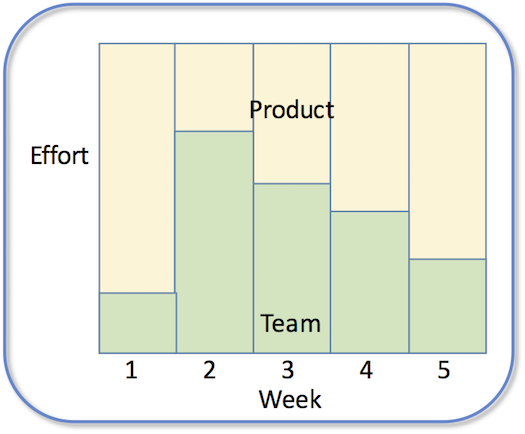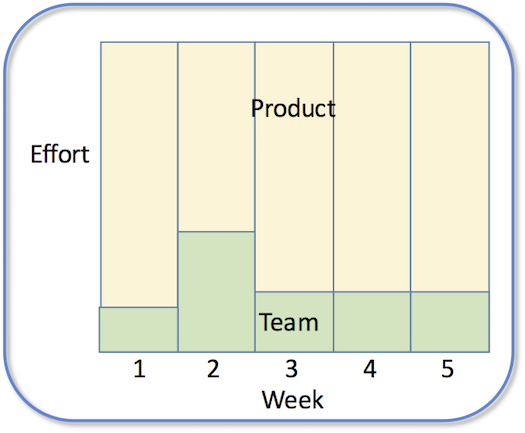- with mixed roles
- analysts, architects, designers, testers, writers, ...
- with mixed personalities
- shy, dominating, leader, follower, neat freak, slob, data nerd, night person, day person, problem solver, problem finder, ...
Teams
The Secret to Success
Teams Make Most Software
Teams Make or Break the Project
- The two least successful 394 teams in one quarter were the most skilled.
- The most successful teams in that quarter and some others were the least skilled.
Team Development is Central to Agile
- The last lines of The Agile Samurai
Whenever you are wondering whether you are doing things the "agile way," instead ask yourself two questions:
- Are we delivering something of value every week?
- Are we striving to continuously improve?
What's Wrong with Your Team
- A few people did all the hard coding
- Some people did almost no coding
- Some people have no idea how much of the app works
- Almost no one knows who anyone else is beyond their name and email
- Some people are clearly more skilled than other people
- Some people are always late to meetings
- Some people dominate every discussion
- Most people believe the #1 myth about teams
Number #1 Myth about Teams
- The purpose of a team is to split up work.
- When you split up the work, you
- lose a shared vision
- make everyone a potential bottleneck
- encourage "my code" attitudes
- maximize work-in-progress
- 4 tasks 25% done => nothing ready to test
- make your Bus Factor = 1
- minimize learning and growth
Divide and conquer is what you do to the problem, not the team.
What Teams Are For
- To gang up on problems -- show no mercy!
- Create and share one vision
- Minimize work-in-progress
- Apply multiple views, skills and perspectives
- Back each other up
- Teach each other
- Have fun!
The Secret to Success: Jelled Teams
- A jelled team is one that is more than the sum of its parts. [Peopleware, 1999]
-
Signs of a jelled team:
- low turnover
- team identity
- team pride
- joint ownership
- having fun
Incremental Agile Team Development
- Speed kills! Don't focus on just the fastest way to get code written
- Never program alone. Swarm and pair.
- Training by pairing
- Weekly team retrospectives
Retrospectives
- Every week
- Identify and then analyze
metrics that matter
, e.g.,
- Buggy code, low productivity, ...
- Bad bus factor, bottlenecks, ...
- Low team morale
- The only practice commonly associated with agile considered essential.
Team Assessment
- The class team review tools:
- Self reflect on your contributions, shared with your team
- Summarize and evaluate your team mate contributions for the week, using the self-reviews and data collected by the team
Common Agile Practices
-
NO SILOS (The Agile Samurai, Chapter 2)
- Divide and conquer is not your friend
- Swarm
- If you plan to code solo, message the team in advance
- If you see such a message, volunteer to help
- Use Facebook, Twitter, group.me or whatever works for low-effort easy communication
Mood charts
- Common: Niko Niko charts
-
Better:
394 Mood Charts
- Easier to see trends with colors
- Easier to see common issues in the texts
- Brevity is key: use mood entries to start a conversation, not make a report.
- Focus on YOUR feeling at the end of the swarm and its cause, no more.
Building the Team
- 5 Ways to Build Relationships in Product Development Teams
- Drucker Exercise
- Invest an hour in getting to know each other beyond
name and major:
- When I like work (night owl, early bird, ...)
- How I attack a problem (dive in, study the terrain, ...)
- What I value (politeness, frankness, listening, leading, ...)
- Where I want to be (developer at startup, big company coder, grad school, ...
Train by Doing
- Integrate development with learning
- Pick developers for a task based on learning needs
-
If pairing:
- Driver = learner
- Navigator = teacher
The Three Essentials to Jelling
-
Trust
- You trust your team so well, you let them know when you're really lost, or when you really mess up.
-
Respect
- You respect each team member and value their contribution, not in spite of how they differ from you, but because of how they differ.
-
Responsibility
- You see the success of the project and the team as your responsibility. Every problem is your problem.
Team Development Takes Time
- 100 hours
- Time you have for this class
- 10,000 hours
How to Invest Your Effort
| Team Project | Client Project |
|---|---|

|

|
How to Improve
- "Never let a good crisis go to waste."
- Problems are opportunities
- Don't hide them
- Study them
- Root cause analysis
- 5 Whys
- If your program crashed...
- ... your code needs better defenses
- ... your process needs better testing
- ... your architecture needs harder to mis-code
- Then make small but effective fixes at multiple levels
- When code breaks, does
- Blaming it help?
- Running it again, but "harder"?
- You diagnose the cause and change the code.
- Fix team problems the same way
Jelling by Process Repair
- No problem is a one-time accident.
- if someone checks in broken code
- if you deliver the client something they didn't want
- if someone's late to team meetings
- ...
Bad Repairs
- Try harder
- Whatever caused the problem before will cause the problem again
- Make a big change
- A brand new process is probably worse than the old one
- Add more process
- This is how software development got in trouble in the first place
- You need to be SMART
Thanks to Hakim El Hattab for RevealJS